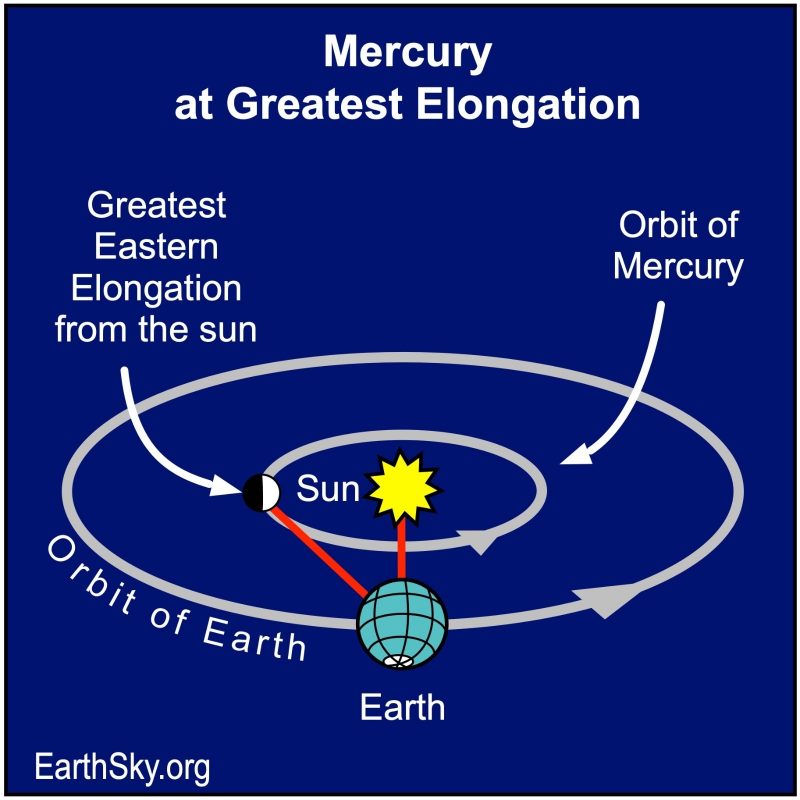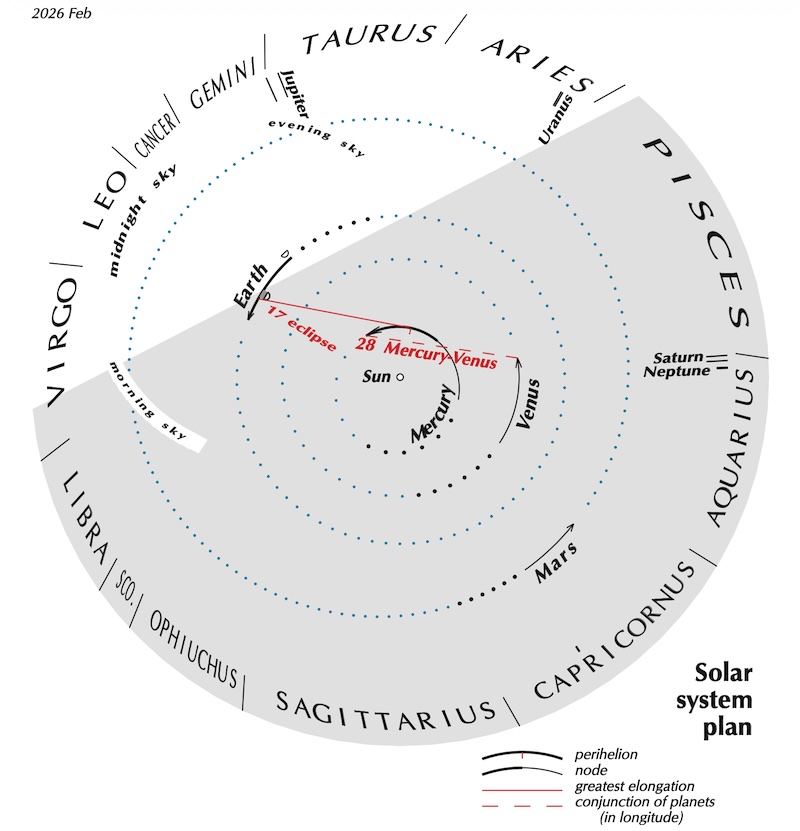
Mercury is our sun’s innermost planet. So it always lies near the sun in our sky. Mercury is now in the west after sunset. This small, speedy planet will reach its greatest elongation, its greatest apparent distance from the sun in our sky on February 19, 2026. And it’ll be near the bright planet Venus and Saturn that night. Look for them in the evening twilight.
Mercury after sunset in February 2026
Where to look: Look west, in the sunset direction – shortly after sunset – for Mercury. And Venus will join it around mid-month nearby shining at -3.9 magnitude. Saturn will also be nearby. Look for them in the western evening twilight. This will be the best evening apparition of Mercury for the Northern Hemisphere in 2026. Plus the moon will be near Mercury on the evening of February 18.
Greatest elongation: Mercury is farthest from the sun on our sky’s dome at 18 UTC (1 p.m. CST) on February 19, 2026. At that time, Mercury will be 18 degrees from the sun in our sky. See A comparison of elongations, below.
Brightness: Mercury emerged in the evening sky early in February. Since then, it’s been shining at around -1.0 magnitude. At greatest elongation it’ll be farther from the sunset glare, shining around 0 magnitude and still brighter than most stars! In the evenings after greatest elongation, the innermost planet will fade rapidly as it starts to move between Earth and the sun, meaning its illuminated side will become less and less visible. It’ll disappear early next month and will reach inferior conjunction – when it passes between Earth and the sun – at 11 UTC on March 7.
Through a telescope: Mercury will appear about 48% illuminated at greatest elongation. It’ll measure 7.18 arcseconds across.
Constellation: Mercury will lie in front of the constellation Pisces the Fish at this elongation. Doubtless, the stars in this constellation will be lost in the twilight.
Note: As the innermost planet, Mercury is tied to the sun in our sky. As a result, it never ventures very far above the horizon after sunset. So as soon as the sun disappears below your horizon, your clock starts ticking. Will you see the glowing point of light that is Mercury before it drops below the horizon, following the setting sun?
For precise sun and Mercury rising times at your location:
timeanddate.com (worldwide)
Stellarium (online planetarium)
Mercury events in 2026
Note: Times are in UTC
Jan 21, 2026: Superior conjunction (passes behind sun from Earth)
Feb 19, 2026: Greatest elongation (evening)
Mar 7, 2026: Inferior conjunction (races between Earth and sun)
Apr 3, 2026: Greatest elongation (morning)
May 14, 2026: Superior conjunction (passes behind sun from Earth)
Jun 15, 2026: Greatest elongation (evening)
Jul 13, 2026: Inferior conjunction (races between Earth and sun)
Aug 2, 2026: Greatest elongation (morning)
Aug 27, 2026: Superior conjunction (passes behind sun from Earth)
Oct 12, 2026: Greatest elongation (evening)
Nov 4, 2026: Inferior conjunction (races between Earth and sun)
Nov 21, 2026: Greatest elongation (morning)
Heliocentric view of Mercury February 2026

A comparison of elongations
In February 2026, Mercury stretches out 18 degrees from the sun in our sky. In fact, the farthest from the sun that Mercury can ever appear on the sky’s dome is about 28 degrees. And the least distance is around 18 degrees.
Mercury (and Venus) elongations are better or worse depending on the time of the year they occur. So in 2026, the Northern Hemisphere will have the best evening apparition in February. And the Southern Hemisphere will have its best evening elongation of Mercury in June.
In the autumn for either hemisphere, the ecliptic – or path of the sun, moon and planets – makes a narrow angle to the horizon in the evening. But it makes a steep slant, nearly perpendicular, in the morning. So, in autumn from either hemisphere, morning elongations of Mercury are best. That’s when Mercury appears higher above the horizon and farther from the glow of the sun. However, evening elongations in autumn are harder to see.
In the spring for either hemisphere, the situation reverses. The ecliptic and horizon meet at a sharper angle on spring evenings and a narrower angle on spring mornings. So, in springtime for either hemisphere, evening elongations of Mercury are best. Meanwhile, morning elongations in springtime are harder to see.

More Mercury evening elongation comparisons for 2026


Bottom line: The sun’s innermost planet, Mercury, will be 18 degrees from the sunset when it reaches its greatest elongation at 18 UTC on February 19. Also, this is the best evening apparition of Mercury in 2026 for the Northern Hemisphere.
Submit your photos to EarthSky here.
Read about greatest elongations, superior and inferior conjunctions: Definitions for stargazers











